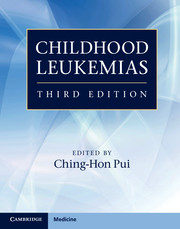Book contents
- Frontmatter
- Contents
- List of contributors
- Preface
- Section 1 History and general issues
- Section 2 Cell biology and pathobiology
- Section 3 Evaluation and treatment
- 12 Pharmacokinetic, pharmacodynamic, and pharmacogenetic considerations
- 13 Acute lymphoblastic leukemia
- 14 Relapsed acute lymphoblastic leukemia
- 15 B-cell acute lymphoblastic leukemia and Burkitt lymphoma
- 16 Acute myeloid leukemia
- 17 Relapsed acute myeloid leukemia
- 18 Myelodysplastic syndrome
- 19 Chronic myeloproliferative disorders
- 20 Leukemias in patients with Down syndrome
- 21 Treatment of adolescents and young adults with acute lymphoblastic leukemia
- 22 Hematopoietic stem cell and natural killer cell transplantation
- 23 Treatment of acute leukemia in countries with limited resources
- 24 Antibody-targeted therapy
- 25 Adoptive cellular immunotherapy
- 26 Gene transfer: methods and applications
- 27 Development therapeutics
- 28 Minimal residual disease
- Section 4 Complications and supportive care
- Index
- Plate Section
- References
27 - Development therapeutics
from Section 3 - Evaluation and treatment
Published online by Cambridge University Press: 05 April 2013
- Frontmatter
- Contents
- List of contributors
- Preface
- Section 1 History and general issues
- Section 2 Cell biology and pathobiology
- Section 3 Evaluation and treatment
- 12 Pharmacokinetic, pharmacodynamic, and pharmacogenetic considerations
- 13 Acute lymphoblastic leukemia
- 14 Relapsed acute lymphoblastic leukemia
- 15 B-cell acute lymphoblastic leukemia and Burkitt lymphoma
- 16 Acute myeloid leukemia
- 17 Relapsed acute myeloid leukemia
- 18 Myelodysplastic syndrome
- 19 Chronic myeloproliferative disorders
- 20 Leukemias in patients with Down syndrome
- 21 Treatment of adolescents and young adults with acute lymphoblastic leukemia
- 22 Hematopoietic stem cell and natural killer cell transplantation
- 23 Treatment of acute leukemia in countries with limited resources
- 24 Antibody-targeted therapy
- 25 Adoptive cellular immunotherapy
- 26 Gene transfer: methods and applications
- 27 Development therapeutics
- 28 Minimal residual disease
- Section 4 Complications and supportive care
- Index
- Plate Section
- References
Summary
Introduction
Most agents currently used in the treatment of leukemia were developed over 30 years ago. The traditional approach to drug discovery and development has been classic single-agent phase I trials that determine a maximally tolerated dose at which efficacy is evaluated in phase II studies prior to incorporation into combination regimens. Responses have been defined by the presence (percentage) or absence of leukemic blasts in the bone marrow based on morphology along with trilineage hematopoietic recovery. With recent advances in molecular and immunologic technology, minimal residual disease (MRD) measurement is increasingly applied in defining response, and novel therapeutic strategies are targeting the leukemia-associated antigens and molecular pathways. The development of new oncology drug classes with novel mechanisms of action brings new challenges. New strategies are needed to efficiently combine immunotherapy and molecular therapy with traditional chemotherapeutics and with each other to maximize leukemic cell kill and minimize toxicity. New definitions of response and relapse are needed to effectively evaluate novel treatments in an era where MRD is increasingly used to assess therapeutic efficacy, and transplant is increasingly performed in patients without full peripheral count recovery. A disciplined application of well-designed clinical trials is needed as new therapeutic options emerge in order to optimize and individualize therapy. Paradigms for the design and conduct of preclinical and early clinical trials are discussed, and novel agents in development are presented in this chapter.
Leukemia as a model for drug development
Leukemia cells are easily accessible for study, allowing assessment of a new agent's activity and providing studies in animal models from which drug dose and schedule dependency can be demonstrated. The concepts of combination chemotherapy, remission induction, and maintenance treatment were all developed in pediatric acute lymphoblastic leukemia (ALL) regimens.
- Type
- Chapter
- Information
- Childhood Leukemias , pp. 616 - 631Publisher: Cambridge University PressPrint publication year: 2012



